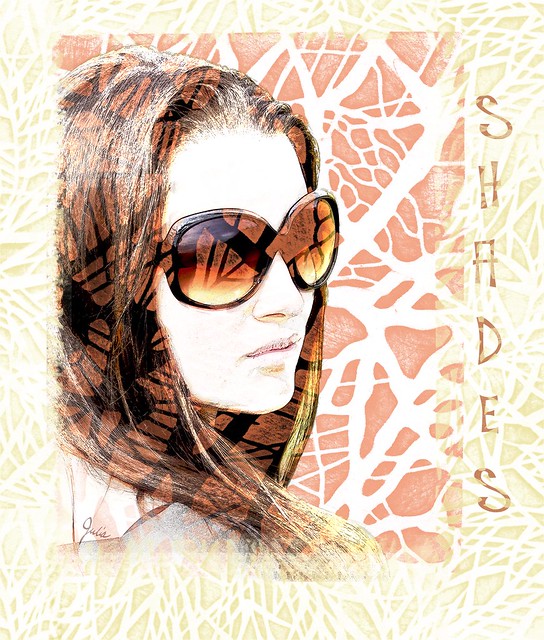
Here I was thinking these two sewing books by Adele P. Margolis were my own personal discovery and little-known secret when they have been heralded on quite a few sewing blogs and reviewed on Pattern Review. I'll have my own say about them in a moment, but first, and perhaps even more interesting, is the author herself who died at age 100 in 2009. Be sure to read this
moving tribute by Ellen Steinbaum, the niece of her lifelong best friend, but let me just mention some salient facts from her reminiscence.

Despite wishing to be an artist, Adele trained as a teacher and taught elementary school from 1930 to 1945. She gave her future husband, Nathan, also a teacher, a set of paints, and he went on to become a recognized artist. His circa 1950 lithograph,
Vogue Says, probably depicts Adele. During the Depression, she began to sew her own clothes and in her 40s started to teach fashion sewing at an adult education school in Philadelphia. From there her "sewing guru" career took off, with the sewing books beginning in 1959. The photograph of her below is scanned in from the dust jacket of one of my books. In her 80s she began writing poetry and published a collection of poems as well as wrote her final (unpublished) sewing book on creating and altering patterns for the older figure.

Reading her books makes me wish I could have known her and taken classes from her. From her breezy yet no-nonsense style, I imagine a warm and encouraging teacher, but one who wouldn't listen to excuses, who would insist on you going beyond your comfort zone, and doing it well. Here's her voice on the subject of draping: "To do draping you must have the courage to cut. If you're apprehensive about cutting, then draping is not for you. Better stick to pattern making. Of course, you're fearful you'll make a mistake. Cutting is so final! Just remember it's only fabric. If you ruin it, there are miles and miles more of the stuff. It's the release from fear of making a mistake you need most of all."
Design Your Own Dress Patterns consists of Part I – Principles of Pattern Construction covering shaping by dart control, refining a pattern, use of multiple darts, shaping by seams, and adding fullness with pleats, gathers, gores, etc. Part II is all about styling: necklines, collars, closures, pockets, sleeves. The final chapter touches on draping, pattern grading, and creating a garment from design to pattern to muslin to determining a layout on your fashion fabric. If you're simply interested in producing a garment or reproducing exactly what you see on the pattern envelope, this book will probably seem tedious. However, if you want to look beneath the hood, so to speak, to understand the whys of what you're sewing and be able to make changes if you so desire, then you'll treasure this tome. Going through each chapter, doing all the exercises (using the quarter-scale models she instructs you to use), you would surely be knowledgeable, proficient and confident by the end. In fact, when I first acquired this book, that's what I intended to do, but, alas, that's still a far-off future project. I have used it on several occasions to add a detail, such as a collar, or redesign a bodice front. Her directions are clear and easy to follow, the line drawings explicit and just looking at them will give you lots of inspiration.
I've used
How to Make Clothes that Fit and Flatter less because when I'm trying to solve a fit problem I look for something specific, more like a modern recipe—move this a certain amount here, fold that in a certain way there, whereas this book is more like a pioneer recipe—add a spoonful of this, a handful of that. Once again, I think this book would be most useful if you were to use it like a textbook and proceed through it as if taking a course. The copyright in my book is 1969, and some of what she has to say certainly reflects another era: "There's absolutely no mystery about it any more! Those old-time unmentionables are today's common knowledge—thanks to present-day advertising. And small wonder—they're so photogenic! So attractive and so comfortable are they also that there really is no excuse for anyone no longer very young or very slender for not wearing what she needs to show off her clothes to best advantage." However, I find that part of the charm of this book, and most of the information she imparts is valid for any time or style.
You can find her out-of-print books readily online, but Dover Publications has also reissued the first book as
Make Your Own Dress Patterns with the original line drawings by her husband.
 This is an alternative version; the four copies of the woman's head were flattened which resulted in a very subtle loss of detail. I then very lightly tinted her skin. The watercolor background is from Deviant Art, recolored with a Hue/Saturation adjustment layer.
This is an alternative version; the four copies of the woman's head were flattened which resulted in a very subtle loss of detail. I then very lightly tinted her skin. The watercolor background is from Deviant Art, recolored with a Hue/Saturation adjustment layer.











